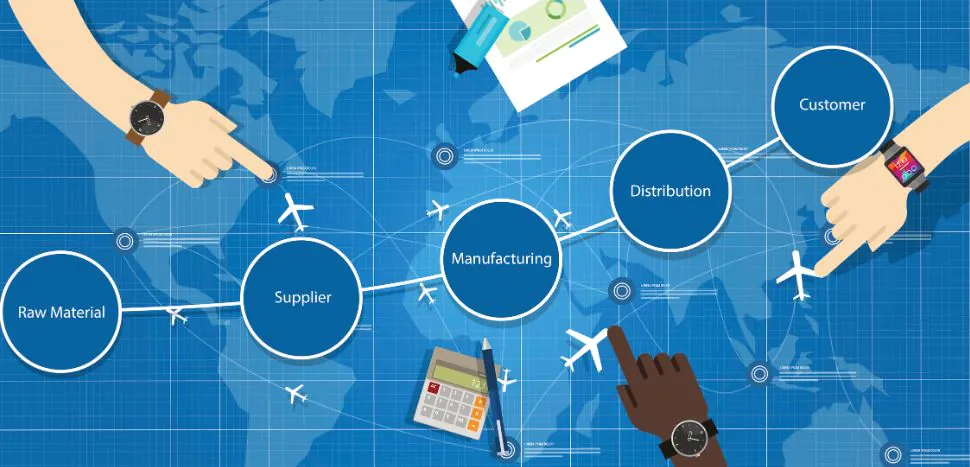Global supply chain issues are present in every organization. If you want to succeed in global supply chains over the next several years, in 2022 and beyond, the following seven issues are ones that you must pay close attention to. These are issues that will affect your entire organization, regardless of how large or small it is. Within the global economy, supply chain organizations face pressing challenges daily. These challenges include (but aren’t limited to) global supply chain shortages, logistics, technology, quality control, and customer service. To remain competitive in their respective industries in 2023, supply chain organizations need to make advancements toward strategic goals that will help them define the future of the industry for years to come. This article will break down the top 7 global supply chain issues and how to solve supply chain problems in 2023.
.
Why Are There Supply Chain Issues?
Why are there global supply chain issues in 2023? Global supply chain issues can be very costly, especially when they involve a material shortage.
A supply chain issue is any disruption in the normal flow of goods from suppliers to customers. These disruptions can affect any part of the supply chain, from shipping, warehousing, and logistics to manufacturing or distribution.
The cost of a supply chain issue is not just financial either — it can also impact brand reputation and customer loyalty. For example, if retailers are unable to stock their shelves with certain products due to a supply chain issue, customers will lose trust in that retailer’s ability to keep their shelves stocked at all times. This can lead them to seek out other retailers who can fulfill their needs instead.
There are many reasons why there are supply chain issues:
- A lack of planning and preparation before an order is placed
- Unclear specifications for the product being purchased or sold
- Inadequate communication between departments within an organization regarding their respective roles in production and delivery
Let BizVibe Help You Solve Your Global Supply Chain Issues. Trusted by Millions.
Are There Still Supply Chain Issues in 2023?
Yes, there are. The current economic situation is still very challenging. The biggest issue is the high unemployment rate. There are not enough jobs to go around, especially for people who have been out of work for a long time. Some companies have resorted to hiring people on a contract basis to fill the gaps in their workforce. But it’s not a sustainable solution.
Companies need to make sure they have enough workers to get the job done, but they also need to make sure that they don’t hire too many people and end up with a lot of idle hands on deck. And then there are other issues like morale and retention rates that can affect productivity if you don’t have enough people to do the work that needs to be done.
Another big issue is dealing with global competition from low-cost countries like China and India, where wages are much lower than what we pay here in the U.S., Canada, Europe, or Australia. We have seen many companies move their factories overseas to save money on manufacturing costs, but that has created problems with supply chains because now these goods come back into our markets at much lower prices than we would normally expect them
However, the biggest global supply chain issues today involve the Russia-Ukraine conflict and recovery from the global Covid-19 pandemic.
7 Global Supply Chain Issues & Strategies For Success in 2023
Global supply chain issues can be caused by events that happen anywhere in the world. These events can include natural disasters, labor strikes, and political unrest. The resulting disruptions can affect business operations, including financial performance and customer satisfaction. These are the top 7 global supply chain issues and how to solve supply chain problems in 2023.
1. Global Supply Chain Shortages
One of the biggest supply chain issues facing businesses today is global supply chain shortages. This is an issue because many raw materials are sourced from overseas countries and transported across oceans to reach their final destination. This can lead to delays and other problems, as well as increasing costs for businesses that rely on these materials.
The reason for this shortage is due to not having enough resources being used in the manufacturing process. As a result, many businesses have had to turn to automation to keep up with demand and reduce costs. These changes have led to the creation of more jobs for robots than humans.
Strategies to Improve Global Supply Chain Shortages
The shortage of global supply chain materials is one of the biggest challenges facing businesses. Many companies are turning to third-party logistics providers (3PLs) to help solve their supply chain shortfalls, but this strategy can be difficult and time-consuming to implement.
3PLs, which specialize in managing outsourced logistics services for other businesses, can provide companies with a wide range of benefits, including:
- Increased visibility into supply chain data
- Improved inventory management
- More effective forecasting
- Reduced operating costs
2. Global Trade Slowdown
The slowdown of global trade is one of the most significant factors affecting supply chains today. According to a study by McKinsey & Company, global trade volumes have declined by 8% over the last year and are likely to decline by another 5% in 2021.
This is partially due to political events like Brexit and US-China trade war, but also because of shifts in consumer preferences toward local production and consumption. At the same time, there has been an increase in competition from emerging markets like India and Mexico which have lower labor costs than Western countries. This has resulted in a dramatic shift in manufacturing locations away from China, which has resulted in lower supply chain efficiency and higher costs for companies doing business globally.
Strategies to Improve the Global Trade Slowdown
To combat this slowdown, companies need to focus on improving their internal processes rather than relying on external factors such as tariffs or currency fluctuations. Shorter lead times will help improve inventory turns and reduce costs through better inventory management practices such as JIT (Just-In-Time) replenishment systems.
3. The Rising Cost of Living
One of the top 7 global supply chain issues in 20222 is the rising cost of living. The cost of living is rising across the world, and this is a major concern for businesses of all sizes. It’s important to keep track of how the supply chain is changing and adjust your strategy accordingly.
The rising cost of living. Businesses need to be aware that the cost of living is rising globally. This means that they will have to pay more for goods and services, which can impact their bottom line if they don’t take action now. To combat this issue, businesses should focus on finding local suppliers who can offer lower prices without sacrificing quality.
As the global population continues to grow, so too does the demand for goods and services. This means that prices have gone up around the world — including in areas where they were already high. Inflation is one thing, but when you factor in other costs like transportation, labor, and utilities it becomes clear why so many companies are struggling with their supply chains right now. The only way to keep up with these rising costs is by optimizing your supply chain network as much as possible.
Strategies to Improve the Rising Cost of Living
One way to reduce costs is by focusing on cost-reduction strategies. One way to do this is by looking at how much inventory you have on hand and how much of it is old or obsolete stock; if you find that you’re carrying too much inventory, then consider selling off some of it to make room for new products or using it as part of an employee incentive program (where employees receive a discount on products they sell). Another tactic is to take a look at your supply chain management processes and see if there are any opportunities where you can improve efficiency and reduce waste — for example, by using more efficient packaging materials or investing in better tracking systems so that you know when each item needs replenishing).
4. Geopolitical Uncertainty
Geopolitical uncertainty is the top supply chain issue of 2022, according to studies.
The study, which surveyed more than 1,000 executives across industries, found that geopolitical uncertainty rose from third to first place in the ranking of supply chain issues. It was also the top-ranked issued by companies in Europe and the Asia Pacific.
Supply chains are increasingly global and complex, with many suppliers and partners located around the world. This means that companies are exposed to a broad range of political risks that can disrupt operations or halt shipments if borders are closed or trade is restricted.
The second most important issue for supply chain leaders is talent scarcity and skills gaps (30%), followed by cyber threats (29%). The researchers found that these issues have been consistently ranked as top concerns over the past three years.
Other top concerns include regulation compliance (25%), natural disasters (21%), and technology obsolescence (17%).
Strategies to Combat Geopolitical Uncertainty in the Supply Chain
The current geopolitical climate creates uncertainty in the supply chain. This uncertainty can have an impact on your supply chain operations and the way you manage your supply base.
Here are five strategies to combat global uncertainty in the supply chain:
- Keep a close watch on global events and identify any impacts that may occur on your supply chain.
- Develop contingency plans for any potential impacts, such as new tariffs or trade restrictions imposed by countries that could result from these events.
- Be flexible when it comes to sourcing products from different countries so you can adjust quickly to changes in the geopolitical environment and avoid disruptions in your operations.
- Take advantage of technology advancements that allow you to monitor and manage your supply base more efficiently, including through data analytics tools like artificial intelligence (AI), machine learning (ML), and robotics automation software platforms that can help make sense of complex data sets such as supplier risk ratings or inventory management information systems (IMIS).
- Make sure all members of your team understand how critical it is to be agile and flexible when it comes to managing the geopolitical risks associated with their roles for them to be successful at doing so
5. Semiconductor Industry Shortages
The semiconductor industry is facing a major supply chain issue: the shortage of silicon. This shortage has been caused by the increasing demand for chips, which has been driven by AI and IoT applications. The semiconductor industry is expected to grow at a CAGR of 4.7% between 2019 and 2024.
The chipmakers are continuously looking for ways to solve this problem, including new materials and new processes. However, the lack of silicon availability will continue to be a challenge for them in the coming years.
The semiconductor industry consists of several subsectors: memory chips, microprocessors, analog ICs, and others (including sensors). Memory chips account for more than half of the revenue generated by this industry segment; they are used in smartphones and other mobile devices where users store their data on flash drives or SD cards. Microprocessors are used in servers and PCs; they have become an essential part of our everyday lives as they control everything from traffic lights to air conditioners. Analog ICs are used in cars and industrial equipment for controlling various functions such as braking systems or speed control mechanisms.
In response to these challenges, the semiconductor industry should consider the following strategies:
- Adapting to 5G networks
- Maintaining a competitive advantage in AI technology
- Focusing on new markets
6. Anti-Competitive Practices
With the increasing complexity of global supply chains, several issues are arising that can affect your business.
These include anti-competitive practices, unfair competition, and price fixing. Today’s global economy presents the risks of conflicts between domestic and international law and differences in legal standards.
Another issue is compliance with regulations and laws throughout the world. Some countries have very different standards for compliance than others, so it’s important to be aware of these differences as well as their implications for your company.
Unfair competition is also an issue that can impact your supply chain. This can include counterfeiting, piracy, trademark infringement, trade secret theft, and patent infringement.
The following strategies will help solve anti-competitive practices:
- Use a business intelligence tool that can monitor your competitors’ pricing and market movements to ensure you’re always offering the best price.
- Provide great customer service and support to ensure customers return to your store again and again.
- Use your existing supply chain infrastructure as an advantage by providing value-added services like inventory management, returns processing, and order fulfillment to meet customer needs locally in their time zone.
- Tap into new technology like 3D printing and automation software for better collaboration with suppliers and improved efficiencies throughout your entire supply chain network.
7. Extreme Weather and Natural Disasters
Extreme weather and natural disasters are on the rise, and they’re affecting supply chains more than ever. An overwhelming majority of supply chain professionals (91%) say they’ve seen a direct impact on their companies due to extreme weather events.
In addition, nearly half (47%) reported that they had been impacted by a natural disaster in the last year. The top three most common impacts were:
- Lost revenue due to business interruption
- Supply chain disruptions due to logistical problems (e.g., trucking)
- Increased costs associated with supply chain recovery
Strategies to Combat Extreme Weather
When it comes to strategies to improve global supply chain issues, external factors such as extreme weather and natural disasters are hard to mitigate.
As we move into 2023, companies must prepare for more extreme weather events by taking steps to protect their supply chains from disruption. Here are some ways you can do that:
- Make sure your suppliers have contingency plans in place for extreme weather events.
- Perform periodic assessments of your suppliers’ ability to withstand extreme weather events.
- Make sure your operations are resilient enough to withstand such events without significant disruption or loss of revenue (if possible).
Global supply chain issues are at the top of the list for C-level executives and high-level managers. Supply chain management is a growing, dynamic business function that requires innovative strategies and problem-solving at each step of the process. With years of experience in supply chain management, Quest Consulting shares seven strategies to ensure your business has a successful global supply chain management system as we enter 2022. This article went into detail about the top 7 global supply chain issues in 2023 and the strategies to mitigate them so that your organization can succeed in 2023.
BizVibe specializes in helping you identify and mitigate supply chain issues. Try BizVibe for free today and manage the pressing global supply chain issues you might be facing.



